Fujifilm X-S10 Review

Introduction
Sporting a smaller body and simpler user interface, the new X-S10 APS-C sensor mirrorless camera marks quite a departure from the usual Fujifilm blueprint.
It's a clear attempt to attract a brand new audience to Fujifilm cameras, who may previously have been put off by the more complex design and larger size of models like the X-T4 and X-Pro3.
The new Fuji XS10 is billed as the ultimate all-rounder that offers something a little bit different to the Fujifilm norm.
Although they look quite different and occupy different price-points, the XS10 and flagship XT4 / XPro3 actually share a lot of similarities when it comes to their core specifications and features.
In terms of its marketing position, it sits above the X-T30 and below the X-T3 and X-T4 in the current X-series range.
In the UK the Fujifilm X-S10 is available now priced at £949 body only, £999 with the XC 15-45mm lens, £1299 with the XF 18-55mm lens, or £1399 with the XF 16-80mm lens.
In the US, the X-S10 body-only costs $999, with the XF 18-55mm F2.8-4 R lens kit $1399, and with the XF 16-80mm F4 R OIS WR lens kit $1499.
Ease of Use
 |
The image sensor used in the X-S10, the X-T4 and the X-Pro3 cameras is exactly the same - they all use the very latest 26 megapixel APS-C sized BSI X-Trans sensor.
All three cameras also share exactly the same X-Processor 4 processor.
So now Fujifilm are offering you not one, not two, but three different ways to achieve exactly the same image quality.
You can choose between the rangefinder design of the X-Pro3 or the DSLR design of the X-T4 and X-S10, and between the larger X-T4 and the smaller X-S10, and still get the same results.
Physically it sits between the X-H and X-T series, looking like those two camera ranges have been merged together to create the new X-S series.
 |
The design of the body and controls is by far the main difference between the XS10 and the XT4.
The new X-S10 is much smaller and lighter than its big brother, and purposedly has a much simpler interface in order to try and make it more appealing to less experienced users.
If you've ever considered a Fujifilm camera but been put of by its plethora of manual controls - something that admittedly a lot of people love with a passion - then the new XS10 will certainly be more up your street.
Instead of the ISO dial, Shutter Speed dial and Exposure Compensation dial found on top of the X-T4, there's just a customisable Function dial on the left and shooting mode dial on the right of the top of the XS10.
And the rear of the X-S10 is slightly simpler too, with the X-T4's D-pad completely disappearing in favour of a more touchscreen reliant interface.
 |
This reduction in the complexity of the controls means that the XS10 is smaller than the X-T4.
Weighing in at 465g and measuring 126 x 85.1 x 65.4mm, the X-S10 is 20% lighter and 10% smaller than the X-T4, which in turn is slightly lighter and smaller than the X-H1 model.
The Fuji X-S10 has an impressively large hand-grip for such a small camera, which is the direct result of the battery being moved into the grip to accommodate the new IBIS unit.
It's big enough to wrap three fingers of your hand around, with your right forefinger operating the shutter button.
The large grip helps to make the camera more stable when paired even with one of Fujifilm's larger telephoto lenses.
Despite being so small and light, the X-S10 offers a very impressive level of build quality – much better than the X-T200, for example - something that we didn't expect from what is after all a sub-£$1000 camera.
 |
An added bonus for some people is the inclusion of a built-in pop-up flash, something that the more pro-oriented XT4 doesn't have.
The only main concession to the more aggressive price-point from a build quality point of view is the complete lack of any weather-sealing - if this is a must-have feature, then you'll need to step-up to the X-T4.
Despite being substantially smaller and lighter than the other two Fujifilm cameras that have IBIS, the X-H1 and X-T4, the new XS10 still manages to squeeze in a very good stabilisation system.
This is the first time that in-body image stabilisation (IBIS) has been incorporated into a mid-range Fujifilm body.
The first Fujifilm camera that had this feature was the now discontinued X-H1, which was launched back in 2017 to not-so-popular acclaim, mainly because it was much bigger than other X-series cameras in order to incorporate the IBIS unit.
 |
Fujifilm's engineers were then hard at work in the intervening three years and managed to drastically shrink the IBIS unit in the X-T4, making it 30% smaller and 20% lighter than the one in the X-H1.
Now with the new Fuji X-S10, they've shrunk the IBIS unit even further still, once again making it 30% smaller and lighter, but this time compared to the one in the X-T4.
The only slight drawback to this impressive size reduction is a modest reduction to the amount of stabilisation that's on offer.
The 5-axis system in the X-T4 provides up to 6.5 shutter steps of compensation, whereas the one in the X-S10 tops out at 6 stops.
This is still half a stop better than the 5.5 offered by the X-H1, though, which is no mean feat given the overall size of the new camera.
 |
The XS10 has a simplified interface that has been designed to be less intimidating to new users who don't already have a vested interest in the Fujifilm X-series system, or to those who don't appreciate manual controls as much as a simpler, more streamlined control layout.
So the X-S10 has a much less complex top-plate compared to the usual array of manual controls that Fujifilm include on their higher-end cameras.
Instead of the ISO dial, Shutter Speed dial and Exposure Compensation dial which adorn the top of the X-T4, there's a Function dial on the left of the X-S10 which by default changes the film simulation mode, and a traditional PASM dial on the right.
Fujifilm have made some improvements on the XS10 to their almost legendary range of film simulation modes and to the beginner-friendly automatic shooting modes.
The new Eterna Bleach Bypass film simulation that first made its debut on the X-T4 has also now been included on the X-S10.
 |
This is principally aimed at videographers who want a similar look to films like Seven, Saving Private Ryan and Fight Club, providing a hard tonality to the footage.
As well as being able to quickly select one of the 18 film simulations using the Function dial, you can view a short description of each one by pressing the Q button.
There's also a brand new algorithm for the Auto and Scene Position shooting modes, where the camera will attempt to automatically improve a landscape image, for example, by applying the clarity control and colour chrome blue to enhance the sky.
There's a new Auto film simulation mode, which chooses between Provia, Velvia and Astia, depending on the scene.
For the very first time, Raw files can be recorded in the Auto and SP shooting modes - previously only Fine or Normal JPEGS could be selected.
 |
The X-S10 impressively offers no less than four Custom shooting modes on the PASM dial, and even better than that, you can choose to store AF/MF and shooting settings in each mode as well as the image quality setting, making it easy to setup different custom modes for different shooting scenarios/techniques. Note that this only works for stills, not movies.
Importantly the X-S10 still offers both front and rear command dials, though, which along with the customisable Function button smake it easy to quickly change the shutter speed, aperture and exposure compensation, depending on which shooting mode you're currently using.
Fujifilm still believe that a built-in flash is an important feature on their lower-mid tier cameras, so the new X-S10 comes with a pop-up flash that's activated by a switch on the left of the top-panel.
Also found on top of the camera are the ISO and Quick Menu buttons, along with a one-touch movie record button and the shutter release button, encircled by the On/Off power switch.
Turning to the rear of the XS10, once again the control layout is simpler when compared to the X-T4.
 |
Despite the lack of traditional Fujifilm manual dials, the X-S10 still provides more than enough controls for the enthusiast user, as well as a simpler interface for beginners.
The unmarked View Mode, AEL and AF ON buttons all double up as customisable Function buttons, while the 8-way AF joystick is a great addition to a mid-range camera.
The X-S10 offers 8fps continuous shooting when using the manual shutter, increasing to 20fps when switching to the electronic shutter without any crop, or 30fps with a 1.29x crop applied.
The electronic viewfinder (EVF) is a 2.36M-dot unit with 0.62x magnification, 100fps refresh rate and a built-in eye sensor. It's exactly the same as the one found in the X-T30.
In comparison, the X-T4 has a more detailed 3.68M-dot OLED electronic viewfinder with larger 0.75x magnification, 100fps refresh rate, and a built-in eye sensor. It's easier to use for glasses wearers because of its larger size and built-in eye-cup, which the X-S10 lacks.
 |
The X-S10 has a 3-inch 1.04M-dot vari-angle LCD screen that can be tilted out to the side and rotated forwards, and also folded against the back of the camera to help protect it when not in use.
You can flip out the screen to the side, rotate it forwards for easier operation when pointing the camera at yourself, and fold it flat against the back of the camera to stop it from getting scratched.
This free-angle design proves to be very versatile screen for vlogging, movie shooting and photography in general.
What differs between the XS10 and XT4 is the resolution of the screen - 1.04M-dots versus 1.62M-dots respectively - which gives the X-T4 a slight edge.
The X-S10 has a pretty good movie mode that more than holds its own against its main rivals.
 |
It offers a highest quality rate of DCI 4K/30p with no crop recorded in 4:2:0 8-bit internally and 4:2:2 10-bit via the micro-HDMI port to an external recorder.
The F-Log profile is available, and movie compression is Long GOP only, with no All Intra option.
The maximum recording time is 30 minutes, which is actually 10 minutes longer than on the X-T4.
The Fuji XS10 also has the 1080p/240p 10x slow-motion mode, first seen on the X-T4, and the same digital image stabiliser which works in conjunction with the in-camera and lens-based systems.
Other key video features include IS Mode Boost, dedicated movie recording mode accessed by the shooting mode dial on top of the camera, different Main menu and Quick menu systems for stills and video modes, a 3.5mm MIC socket and a USB-C to headphone adapter provided in the box.
Finally the X-S10 has a brand new video feature never before seen on a Fujifilm camera - a count-up clock that displays the card capacity in hours and minutes when the camera is in Standby mode, which switches to showing the recording time in minutes and seconds in the Record screen.
 |
So the main differences between the XS10 and the X-T4's video mode are the maximum frame rate in 4K - 30fps versus 60fps -, the movie compression - Long GOP versus Long GOP/All Intra -, the internal bit rate - 8-bit versus 10-bit -, and the recording time - 30 mins versus 20 mins.
The new X-S10 has exactly the same hybrid autofocus system with phase detection and and contrast detections points as the X-T4 and X-Pro3.
In the Single point AF mode there are up to 425 selectable AF points arranged in a 25x17 grid. Alternatively, the camera can be set to 117 points in a 13x9 grid, and the size of the points can also be varied.
In addition to Single point AF, there’s Zone AF which allows the AF points to be selected in 3x3, 5x5 or 7x7 groups, and Wide/Tracking AF.
The AF mode can also now be selected when using the Auto and SP shooting modes, with a choice of single point, zone and wide (previously only wide was available).
Perhaps unsurprisingly given its size, the Fujifilm X-S10 only has a single SD UHS-II memory card slot, rather than the X-T4's dual card slots.
 |
What's more, on the XS10 the memory card slot is next to the battery in a shared compartment on the bottom of the camera, whereas on the X-T4 the memory cards are housed behind a lockable door on the side of the camera.
So the location of the memory card on the XS10 is less convenient and the single memory card slot is less flexible and offers less peace of mind than the dual slots on the XT4.
The Fujifilm X-S10 uses exactly the same NP-126S battery as the X-T30, rather than the larger capacity NP-W235 battery as the X-T4 model.
This offers a CIPA-rated battery life of up to 325 shots on a single charge when using the LCD screen, compared with 500 for the XT4.
Both cameras can also be powered and charged via a USB-C connection, which is useful if you're out and about and have a compatible powerbank to plug the camera into.
Image Quality
All of the sample images in this review were taken using the 26.1 megapixel Raw + Fine JPEG setting, which gives an average image size of around 55Mb and 10Mb respectively.
With an identical sensor to the Fujifilm X-T4, the X-S10 boasts similarly outstanding image quality.
The native sensitivity range is ISO 160 to ISO 12,800, which can be expanded to ISO 80 to ISO 51,200.
In JPEG images there is no visible sign of noise all the way up to ISO 6400, which is mightily impressive for an APS-C sensor.
The impact of noise at ISO 12,800 is seen through a minor colour desaturation and smudged detail in shadow areas.
The extended high settings of ISO 25,600 and ISO 51,200 progressively exhibit more noise but those images are still useable.
We like the application of noise reduction in those JPEG images - it's not too heavy handed so as to overly smudge detail.
In RAW files where no noise reduction is applied, noise is more evident but images still look pretty clean up to ISO 12,800.
We would happily shoot the entire native ISO range in RAW and JPEG and it's not often that we could say that about a camera.
Elsewhere, we love the Fujifilm colour science. The sensor of the XS10 uses a different colour array to other brands and the results are lovely, especially when you factor in the choice of Fujifilm’s film simulation for different colour effects. Provia is the standard mode and we are partial to the Eterna Cinema mode.
The Fujifilm X-S10 has an excellent sensor that provides crisp images full of detail come day or night.
Noise
There are 11 ISO settings available for the Fujifilm X-S10 for RAW and JPEG files. Here are some 100% crops which show the levels of noise for each ISO setting.
| JPEG | RAW |
ISO 80 (100% Crop) |
ISO 80 (100% Crop) |
 |
 |
ISO 160 (100% Crop) |
ISO 160 (100% Crop) |
 |
 |
ISO 200 (100% Crop) |
ISO 200 (100% Crop) |
 |
 |
ISO 400 (100% Crop) |
ISO 400 (100% Crop) |
 |
 |
ISO 800 (100% Crop) |
ISO 800 (100% Crop) |
 |
 |
ISO 1600 (100% Crop) |
ISO 1600 (100% Crop) |
 |
 |
ISO 3200 (100% Crop) |
ISO 3200 (100% Crop) |
 |
 |
ISO 6400 (100% Crop) |
ISO 6400 (100% Crop) |
 |
 |
ISO 12800 (100% Crop) |
ISO 12800 (100% Crop) |
 |
 |
ISO 25600 (100% Crop) |
ISO 25600 (100% Crop) |
 |
 |
ISO 51200 (100% Crop) |
ISO 51200 (100% Crop) |
 |
 |
File Quality
The Fujfilm X-S10 shoots in RAW and JPEG with two quality settings; Fine and Normal . Here are 100% crops of those three options with the files size shown in brackets.
| Fine (13.7Mb) (100% Crop) | Normal (8.37Mb) (100% Crop) |
 |
 |
| RAW (55.7Mb) (100% Crop) | |
 |
Night
Set the shutter speed dial to its S position (Shutter Speed Priority) and shutter speeds up to 15 minutes are available.
Combined with such a good control over noise, the X-S10 is an excellent night shooter.

Dynamic Range
A dynamic range (DR) boost is always on, with a choice between auto, 100%, 200% and 400%. We taken have identical images going through this range of settings and the visible difference of detail in the extreme shadow and highlights areas is actually rather subtle. As such, for the most part we kept DR in the auto setting.
There is also a HDR option with options of Auto, 200%, 400%, 800% and 800%+. Multiple images are recorded and combined into one final image of greater dynamic range. With both IBIS and OIS active and rapid multi-frame capture, it is entirely possibly to use the HDR mode handheld (depending on your shutter speed).
100% |
 |
200% |
 |
400% |
 |
Film Simulations
There are 12 different film simulation modes, two of which (Acros and Black & White) have several sub-options.
Provia / Standard |
 |
Velvia / Vivid |
 |
Astia / Soft |
 |
Classic Chrome |
 |
Eterna |
 |
Pro Neg Standard |
 |
Pro Neg Hi |
 |
Classic Neg |
 |
Eterna Bleach Bypass |
 |
Acros |
 |
Monochrome |
 |
Sepia |
 |
Advanced Filters
Another setting on the shooting mode dial is Filter. There are 13 different filter effects (six of which are partial colour effects) that are visible on screen when the mode is active. From Toy Camera to High-Key and Low-Key, we've included these 13 effects below.
Toy Camera |
 |
Pop Color |
 |
| High-Key |
 |
Low-Key |
 |
Dynamic Tone |
 |
Miniature |
 |
Partial Color (Red) |
 |
Partial Color (Orange) |
 |
Partial Color (Yellow) |
 |
Partial Color (Green) |
 |
Partial Color (Blue) |
 |
| Partial Color (Purple) |
 |
| Soft Focus |
 |
Sample Images
This is a selection of sample images from the Fujifilm X-S10 camera, which were all taken using the 26 megapixel Fine JPEG setting. The thumbnails below link to the full-sized versions, which have not been altered in any way.
1/210s · f/8 · ISO 160
27mm
Download Original
1/320s · f/8 · ISO 160
83mm
Download Original
1/42s · f/5.6 · ISO 160
27mm
Download Original
1/210s · f/4 · ISO 160
56mm
Download Original
1/42s · f/8 · ISO 400
43mm
Download Original
1/125s · f/4 · ISO 160
69mm
Download Original
1/80s · f/4 · ISO 160
73mm
Download Original
1/90s · f/4 · ISO 160
83mm
Download Original
1/26s · f/11 · ISO 500
27mm
Download Original
1/52s · f/11 · ISO 640
54mm
Download Original
1/50s · f/8 · ISO 200
49mm
Download Original
1/80s · f/4 · ISO 400
83mm
Download Original
1/80s · f/4 · ISO 320
83mm
Download Original
1/27s · f/11 · ISO 160
27mm
Download Original
1/80s · f/11 · ISO 500
83mm
Download Original
1/80s · f/11 · ISO 400
83mm
Download Original
1/26s · f/11 · ISO 320
27mm
Download Original
1/250s · f/4 · ISO 160
83mm
Download Original
1/26s · f/8 · ISO 1250
27mm
Download Original
1/80s · f/4 · ISO 320
83mm
Download Original
1/26s · f/11 · ISO 2500
27mm
Download Original
1/80s · f/4 · ISO 1250
83mm
Download Original
1/34s · f/8 · ISO 640
35mm
Download Original
1/80s · f/8 · ISO 640
83mm
Download Original
Sample RAW Images
The Fujifilm X-S10 enables users to capture RAW and JPEG format files. We've provided some Fujifilm RAW (RAF) samples for you to download (thumbnail images shown below are not 100% representative)."
1/210s · f/8 · ISO 160
27mm
Download original
1/320s · f/8 · ISO 160
83mm
Download original
1/42s · f/5.6 · ISO 160
27mm
Download original
1/210s · f/4 · ISO 160
56mm
Download original
1/42s · f/8 · ISO 400
43mm
Download original
1/125s · f/4 · ISO 160
69mm
Download original
1/80s · f/4 · ISO 160
73mm
Download original
1/90s · f/4 · ISO 160
83mm
Download original
1/26s · f/11 · ISO 500
27mm
Download original
1/52s · f/11 · ISO 640
54mm
Download original
1/50s · f/8 · ISO 200
49mm
Download original
1/80s · f/4 · ISO 400
83mm
Download original
1/80s · f/4 · ISO 320
83mm
Download original
1/27s · f/11 · ISO 160
27mm
Download original
1/80s · f/11 · ISO 500
83mm
Download original
1/80s · f/11 · ISO 400
83mm
Download original
1/26s · f/11 · ISO 320
27mm
Download original
1/250s · f/4 · ISO 160
83mm
Download original
1/26s · f/8 · ISO 1250
27mm
Download original
1/80s · f/4 · ISO 320
83mm
Download original
1/26s · f/11 · ISO 2500
27mm
Download original
1/80s · f/4 · ISO 1250
83mm
Download original
1/34s · f/8 · ISO 640
35mm
Download original
1/80s · f/8 · ISO 640
83mm
Download original
Sample Movie & Video
This is a sample movie at the quality setting of 4096x2610 pixels at 30 frames per second. Please note that this 30 second movie is 373Mb in size.
Product Images



























Conclusion
The new Fujifilm X-S10 is an intriguingly different proposition to the X-T and X-H series cameras in terms of its size and design, yet one that offers the same image quality and a lot of the core features at a much lower price-point.
They may look quite different, but at heart the new XS10 and the flagship XT4 are remarkably similar in terms of their image quality and feature-set, so much so that for a lot of users the XS10 will more than meet their needs.
Users who should probably jump for the X-T4 are keen videographers who need 4K/60p 10-bit quality, anyone who wants to use their camera in more inclement weather conditions, sports shooters who will benefit from the 15fps burst mode, and more experienced photographers who strongly value the array of manual controls that have adorned higher-end Fujifilm X-series cameras ever since they made their debut.
Otherwise, the X-S10 makes a lot of sense for a lot of people, being smaller, lighter, cheaper and simpler to use than the X-T4, whilst essentially offering the same stills image quality and only a small concession on the video side of things.
The Fuji X-S10's main rivals are the Nikon Z50, Sony A6600 and Canon EOS M6 Mk II, all cameras that also have APS-C sensors, but all lacking the breadth of lens support that Fujifilm currently offers (35 native lenses in total).
Overall, the X-S10 successfully takes the Fujifilm X-series in a new direction, unashamedly attempting to appeal to a broader audience, but still retaining the same image quality and colour science that Fuji fans have come to know and love.
| Ratings (out of 5) | |
|---|---|
| Design | 4.5 |
| Features | 4 |
| Ease-of-use | 4.5 |
| Image quality | 5 |
| Value for money | 4.5 |
Main Rivals
Listed below are some of the rivals of the Fujifilm X-S10.
Canon EOS M6 Mark II
The Canon EOS M6 Mark II is a new mid-range mirrorless camera with a 32 megapixel APS-C sensor, 4K video recording, 14fps burst shooting, a tilting touchscreen and optional electronic viewfinder. Can it beat the likes of the Sony A6400 and Fujifilm X-T30 cameras? Find out now by reading our Canon EOS M6 Mark II review...
Fujifilm X-Pro3
The latest version of Fujifilm's much-loved rangefinder camera series has just arrived in the form of the X-Pro3, complete with hybrid optical / electronic viewfinder and a radical new hidden LCD screen. Yes, we did say hidden! Read our in-depth Fujifilm X-Pro3 review to find out what this very traditional, yet thoroughly modern camera has to offer you.
Fujifilm X-T30
Dubbed the Little Giant by Fujifilm, the new X-T30 mirrorless camera takes most of the things that we loved about the flagship X-T3 and packages them into a smaller, lighter body. It even has a few tricks up its sleeve that the X-T3 doesn't currently offer, most notably a more advanced auto-focusing system. Read our Fujifilm X-T30 review to find out how it compares to the X-T3 and the previous X-T20, and why you should definitely consider buying this new mid-range mirrorless camera...
Fujifilm X-T4
The Fujifilm X-T4 is the successor to the very popular X-T3, which was released in 2018, principally adding in-body image stabilisation, greatly improved battery life, a quicker and quieter mechanical shutter, enhanced continuous AF and a number of design tweaks. Can the new X-T4 improve on what was already an outstanding camera? Find out now by reading our in-depth Fujifilm X-T4 review...
Nikon Z50
Nikon have introduced their first APS-C, cropped-sensor mirrorless camera with the launch of the Z50, accompanied by two kit zoom lenses. Can the Z50 take on the likes of the well established Sony A6000-series and Canon EOS-M range, not to mention Fujifilm with its line-up of excellent APS-C bodies and lenses? Find out now by reading our in-depth Nikon Z50 review.
Sony A6600
The A6600 is the new all-singing, all-dancing flagship camera in Sony's extensive range of APS-C mirrorless cameras, but does it offer enough to out-gun both its main rivals and its cheaper siblings? Find out now by reading our in-depth Sony A6600 review, complete with full-size sample images and videos.
Specifications
| Number of effective pixels | 26.1 millions pixels | |
| Image sensor | 23.5mm x 15.6mm (APS-C) X-Trans CMOS 4 with primary color filter. | |
| Sensor Cleaning system | Ultra Sonic Vibration | |
| Storage media | SD memory card ( - 2GB) / SDHC memory card ( - 32GB) / SDXC memory card ( - 2TB) | |
| UHS-I | ||
| File format of still image | JPEG: Exif Ver.2.3 *1 RAW: 14bit RAW (RAF original format) |
|
| Number of recorded pixels | [L]<3:2> 6240 x 4160 <16:9> 6240 x 3512 <1:1> 4160 x 4160 | |
| [M]<3:2> 4416 x 2944 <16:9> 4416 x 2488 <1:1> 2944 x 2944 | ||
| [S]<3:2> 3120 x 2080 <16:9> 3120 x 1760 <1:1> 2080 x 2080 | ||
| Lens mount | FUJIFILM X mount | |
| Sensitivity | Standard output | AUTO1 / AUTO2 / AUTO3 (up to ISO12800) / ISO160 - 12800 (1/3 step) |
| Extended output | ISO80 / 100 / 125 / 25600 / 51200 | |
| Exposure control | TTL 256-zone metering, Multi / Spot / Average / Center Weighted | |
| Exposure mode | P (Program AE) / A (Aperture Priority AE) / S (Shutter Speed Priority AE) / M (Manual Exposure) | |
| Exposure compensation | -5.0EV - +5.0EV 1/3EV step (Movie: -2.0EV - +2.0EV) | |
| Image stabilizer | Mechanism | Image sensor shift mechanism with 5-axis compensation |
| Compensation Effect | Maximum 6.0 stops (based on CIPA standard. Pitch/yaw shake only. | |
| Digital Image Stabilization | Yes (movie mode only) | |
| IS MODE BOOST | Yes (movie mode only) | |
| Shutter type | Focal Plane Shutter | |
| Shutter speed | Mechanical Shutter | P mode: 4sec. to 1/4000sec. A mode: 30sec. to 1/4000sec. S/M mode: 15min. to 1/4000sec. Bulb mode: up to 60min. |
| Electronic Shutter *2 | P mode: 4sec. to 1/32000sec. A mode: 30sec. to 1/32000sec. S/M mode: 15min. to 1/32000sec. Bulb mode: 1sec. Fixed | |
| Mechanical + Electronic shutter |
P mode: 4sec. to 1/32000sec. A mode: 30sec. to 1/32000sec. S/M mode: 15min. to 1/32000sec. Bulb mode: up to 60min. | |
| Movie | 1/4000sec. - 1/24sec. (depends on the frame rate) | |
| Synchronized shutter speed for flash | 1/180sec. or slower | |
| Continuous shooting | Approx. 30fps [Only electronic shutter, 1.25 x Crop ] (JPEG: 29 frames Lossless compressed RAW: 17 frames Compressed RAW: 17 frames Uncompressed RAW: 17 frames) | |
| Approx. 20fps [Only electronic shutter, 1.25 x Crop ] (JPEG: 79 frames Lossless compressed RAW: 17 frames Compressed RAW: 20 frames Uncompressed RAW: 17 frames) | ||
| Approx. 10fps [Only electronic shutter, 1.25 x Crop ] (JPEG: 153 frames Lossless compressed RAW: 18 frames Compressed RAW: 26 frames Uncompressed RAW: 18 frames) | ||
| Approx. 20fps [Only electronic shutter ] (JPEG: 32 frames Lossless compressed RAW: 17 frames Compressed RAW: 17 frames Uncompressed RAW: 17 frames) | ||
| Approx. 10fps [Only electronic shutter ] (JPEG: 81 frames Lossless compressed RAW: 18 frames Compressed RAW: 21 frames Uncompressed RAW: 18 frames) | ||
| Approx. 8fps (JPEG: 105 frames Lossless compressed RAW: 18 frames Compressed RAW: 23 frames Uncompressed RAW: 18 frames) | ||
| Pre-shot: Approx. 30fps [Only electronic shutter, 1.25 x Crop ] (max. 10 frames while half press, max. 15 frames after full press, total max. 25 frames) | ||
| Pre-shot: Approx. 20fps [Only electronic shutter, 1.25 x Crop ] (max. 10 frames while half press, max. 48 frames after full press, total max. 58 frames) | ||
| Pre-shot: Approx. 10fps [Only electronic shutter, 1.25 x Crop ] (max. 10 frames while half press, max. 110 frames after full press, total max. 120 frames) | ||
| *Recordable frames depends on recording media | ||
| *Speed of continuous shooting depends on shooting environment and shooting frames | ||
| Auto bracketing | AE Bracketing (Frames: 2, 3, 5, 7, 9 Step: by 1/3EV step, up to ±3EV steps) | |
| Filmsimulation bracketing (Any 3 types of film simulation selectable) | ||
| Dynamic Range Bracketing (100%, 200%, 400%) | ||
| ISO sensitivity Bracketing (±1/3EV, ±2/3EV, ±1EV) | ||
| White Balance Bracketing (±1, ±2, ±3) | ||
| Focus Bracketing (Frames: 1 - 999, Step: 1-10, Interval: 0 - 10s) | ||
| Focus | Mode | Single AF / Continuous AF / MF |
| Type | Intelligent Hybrid AF (TTL contrast AF / TTL phase detection AF) |
|
| Low-light Performance | Contrast: -4.0EV Phase Detection: -7.0EV (XF50mmF1.0 attached) | |
| AF frame selection |
Single point AF: EVF / LCD: 13 x 9 / 25 x 17 (Changeable size of AF frame) Zone AF: 3 x 3 / 5 x 5 / 7 x 7 from 91 areas on 13 x 9 grid Wide/Tracking AF *AF-S: Wide / AF-C: Tracking All |
|
| White balance | Auto (WHITE PRIORITY, AUTO, AMBIENCE PRIORITY), / Custom1 - 3 / Color temperature selection (2500K - 10000K) / Preset: Fine, Shade, Fluorescent light (Daylight), Fluorescent light (Warm White), Fluorescent light (Cool White), Incandescent light, Underwater |
|
| Self-timer | 10sec. / 2sec. | |
| Interval timer shooting | Yes (Setting: Interval, Number of shots, Starting time) | |
| Flash | Manual pop-up flash (Super Intelligent Flash) | |
| Flash modes | SYNC. MODE | 1ST CURTAIN / 2ND CURTAIN (When SYNC TERMINAL on the hot shoe is used) |
| FLASH MODE | TTL (TTL AUTO (P mode) / STANDARD / SLOW SYNC. ) / MANUAL / COMMANDER / OFF (When BUILT-IN FLASH is set) TTL (TTL AUTO (P mode) / STANDARD / SLOW SYNC. ) / MANUAL / MULTI / OFF (When SHOE MOUNT FLASH is set) |
|
| Hot shoe | Yes (Dedicated TTL Flash compatible) | |
| Viewfinder | 0.39 inch approx. 2.36 millions dots OLED Color Viewfinder | |
| LCD monitor | 3.0 inch, aspect ratio 3:2, approx. 1.04 millions dots touch screen color LCD monitor(approx. 100% coverage) | |
| Movie recording | File format | MOV (MPEG-4 AVC/H.264, Audio: Linear PCM / Stereo sound 24bit / 48KHz sampling) MP4 (MPEG-4 AVC/H.264, Audio: AAC) |
| Movie compression | Long-GOP | |
| File size Frame rate Recording time |
[DCI 4K(4096×2160)] 29.97p/25p/24p/23.98p 200Mbps/100Mbps up to approx. 30min [4K(3840×2160)] 29.97p/25p/24p/23.98p 200Mbps/100Mbps up to approx. 30min [Full HD(2048 ×1080)] 59.94p/50p/29.97p/25p/24p/23.98p 200Mbps/100Mbps/50Mbps up to approx. 30min. [Full HD(1920×1080)] 59.94p/50p/29.97p/25p/24p/23.98p 200Mbps/100Mbps/50Mbps up to approx. 30min. "[Full HD(1920×1080) High speed rec.] 240p / 200p 200Mbps(recording) up to approx. 3min. 120p / 100p 200Mbps(recording) up to approx. 6min." *The recording time is measured in test conditions at 25°C. The recording time depends on the shooting conditions. *For recording movies, use a SD memory card with UHS Speed Class 3 or higher. |
|
| Film simulation mode | 18 modes (PROVIA/Standard, Velvia/Vivid, ASTIA/Soft, Classic Chrome, PRO Neg.Hi, PRO Neg.Std, Black & White, Black & White+Ye Filter, Black & White+R Filter, Black & White+G Filter, Sepia, ACROS, ACROS+Ye Filter, ACROS+R Filter, ACROS+G Filter, ETERNA/Cinema, Classic Neg, ETERNA BLEACH BYPASS) Monochromatic Color |
|
| Clarity setting | ±5 steps | |
| HDR mode | AUTO, 200%, 400%, 800%, 800% + | |
| Grain effect | Roughness: STRONG, WEAK, OFF Size: LARGE, SMALL | |
| Color chrome effect | STRONG, WEAK, OFF | |
| Color chrome Blue | STRONG, WEAK, OFF | |
| Dynamic range setting | Still | AUTO, 100%, 200%, 400% ISO restriction (DR100%: No limit, DR200%: ISO320 or more, DR400%: ISO640 or more) |
| Movie | 100%, 200%, 400% ISO restriction (DR100%: No limit, DR200%: ISO320 or more, DR400%: ISO640 or more) |
|
| Advanced filter | Toy camera, Miniature, Pop color, High-key, Low-key, Dynamic tone, Soft focus, Partial color (Red / Orange / Yellow / Green / Blue / Purple) |
|
| Wireless transmitter |
Standard | IEEE802.11b/g/n (standard wireless protocol) |
| Encryption | WEP / WPA / WPA2 mixed mode | |
| Access mode | Infrastructure | |
| Bluetooth® | Standard | Bluetooth Ver 4.2 (Bluetooth low energy) |
| Operating frequency (Center frequency) | 2402 - 2480MHz | |
| Terminal | Digital interface | USB Type-C (USB3.2 Gen1 x 1) |
| HDMI output | HDMI micro connector (Type D) | |
| Other | ø3.5mm, stereo mini connector (for Microphone and Remote Release), Hot shoe | |
| Power supply | NP-W126S Li-ion battery (included) | |
| Battery life for still images*4 | Approx. 325 frames (Normal Mode) When XF35mmF1.4 R is set. | |
| Actual battery life of movie capture*4 *Face detection is set to OFF |
[4K] approx. 40min. (29.97p) [Full HD] approx. 40min. (59.94p) |
|
| Continuance battery life of movie capture*4 *Face detection is set to OFF |
[4K] approx. 55min. (29.97p) [Full HD] approx. 65min. (59.94p) |
|
| Dimensions | (W) 126.0mm × (H) 85.1mm × (D) 65.4mm (minimum depth 32.9mm) | |
| Weight | Approx. 465g (including battery and SD memory card) Approx. 415g (excluding battery and SD memory card) |
|
| Operation Environment |
Operating Temperature | 0°C - +40°C |
| Operating Humidity | 10% - 80% (no condensation) | |
| Starting up period | Approx. 0.4sec. | |
| Accessories included | Li-ion battery NP-W126S USB cable Headphone adapter Shoulder strap Body cap Owner's manual |
|
News
The Fujifilm X-S10 is a new 26 megapixel APS-C sensor mirrorless camera with in-body image stabilisation, 4K/30P 4:2:2 10-bit video, high-speed full-HD recording at 240p and a vari-angle LCD monitor.
The Fuji XS10 will be available from mid-November priced at £949 / $999 body only, £999 with the XC 15-45mm F3.5-5.6 OIS PZ lens, £1299 / $1399 with the XF 18-55mm F2.8-4 R lens, and £1399 / $1499 with the XF 16-80mm F4 R OIS WR lens.
Fujifilm UK Press Release
Small, powerful and easy to use: FUJIFILM introduces the X-S10 mirrorless digital camera
Offering up to 6.0-stops of image stabilisation from an IBIS packed into a compact and lightweight body, the X-S10 is a high-end performance model with user-friendly controls
FUJIFILM Corporation (President: Kenji Sukeno) is pleased to announce the launch of FUJIFILM X-S10, the newest addition to the X Series family of compact and lightweight mirrorless digital cameras. Available in mid-November with a variety of lens kit options, the X-S10 is equipped with top features including a 26.1MP X-TransTM CMOS 4 sensor, a high-speed image processing engine and in-body image stabilisation (IBIS). Powerful yet small, the X-S10 is easy to use and produces impressive image quality in a compact body.
The X-S10 is a perfect fit for anyone who needs a lightweight camera with professional features for both photo and video. It offers something for everyone; the popular AUTO/SP (Scene Position) Mode automatically adjusts the camera settings to produce stunning images without the need to make fine adjustments to images settings.
The advanced video capabilities can either produce sharp 4K/30P 4:2:2 10-bit video or high-speed full-HD video at 240fps. The vari-angle LCD screen that can also be flipped forward 180 degrees, giving everyone from photographers and filmmakers to vloggers and hobbyists something to love about this camera.
1. A newly developed, smaller IBIS for its compact body
The camera’s in-body image stabilisation (IBIS) mechanism is approximately 30% smaller in volume and weight than the previous model*. Despite its small size of just 450g (1.21lb), the X-S10 delivers up to 6.0-stops* of five-axis image stabilisation. It is also the first mid-range X Series camera to use a motion sensor retention mechanism, which is a mechanical shock absorber that guards against slight vibrations that may come from the shutter unit, adding another level of stability to ensure that image clarity and resolution are maintained.
To further assist with hand-held stability, the X-S10 features a large, ergonomic magnesium-alloy grip, making it easier to keep the camera stable when larger lenses are mounted. The design also features a magnesium-alloy front and top-plate to keep the body rigid and robust.
* In comparison with the IBIS function featured in the mirrorless digital camera “FUJIFILM X-T4”
*Offering a 6.0-stop advantage to 20 out of 30 interchangeable lenses for the X Series (XF/XC lenses), currently available
2. FUJIFILM’S legendary Film Simulations and updated AUTO functions for outstanding image quality
FUJIFILM’s iconic Film Simulation modes were created to celebrate the history of photographic film by digitising some of the industry’s most iconic analog films. The X-S10 features 18 exclusive modes, including ETERNA Bleach Bypass, which creates a beautiful, de-saturated, high-contrast look.
The X-S10 also offers an updated [AUTO / SP (Scene Position)] mode automatically adjusts shooting settings to suit a given scene, without the need to make fine adjustments in settings. . Now, photographing landscapes with clarity and vivid colors, making portraits with beautiful skin tones, or creating evenly balanced images in back-lit conditions is possible, regardless of skill level.
3. Dependable AF and high-speed burst mode performance for those important moments
The combination of the X-S10’s high-speed AF and AF-tracking performance with the X-TransTM CMOS 4 sensor’s 2.16 million phase detection pixels and X-Processor 4’s computing power provides quick and accurate autofocus results, achieving focus in as fast as 0.02 seconds in some cases, even at -7.0 EV*.
The X-S10 is equipped with high-precision Tracking AF for moving subjects and Face / Eye AF function to track a subject’s face and eyes. Blackout-free high-speed burst shooting* of 8fps in the mechanical shutter and 30fps in the electronic shutter can also be achieved.
*When the XF50mmF1.0 is mounted
*High-speed continuous shooting without blackout, in which the viewfinder goes dark during shooting, causing the user to lose sight of the subject; This is only available when using the electronic shutter.
4. Vari-angle LCD monitor and viewfinder that supports three boost modes
The X-S10 has a vari-angle LCD monitor that can rotate up to 180 degrees, making it useful not only for selfies but also to make stills and videos from various camera positions.
The viewfinder’s Live View function has three Boost modes available including Low Light Priority, Resolution Priority model, and Frame Rate Priority.
5. Extensive video-recording functions
The X-S10 generates 4K video from the amount of data equivalent to 6K to ensure the footage is in high resolution with low noise. It supports recording 4K/30p 4:2:0 8-bit video onto an SD camera inserted in the camera, and outputting 4K/30p 4:2:2 10-bit video via the HDMI port. The camera is also capable of high-speed full-HD recording at 240p, producing up to 10x slow-motion footage of a split-second motion of a fast-moving subject.
In addition to the camera’s IBIS, its Digital Image Stabilization (DIS) mode will powerfully compensate for any camera shake even when walking with the camera. Adding IS Mode Boost provides even more stabilization, nearly eliminating camera shake when it is used from a fixed, hand-held position.
With a dedicated movie recording button on its top-plate, the X-S10 lets users start a recording video even while they are creating still images. Exposure and focus settings are automatically recorded in AUTO mode*.
* The AF mode switches to Continuous AF.
Pricing, images and availability
The X-S10 will be available from mid-November and priced as follows:
Fujifilm X-S10 Body Only - Black £949
Fujifilm X-S10 with XC15-45mmF3.5-5.6 OIS PZ - Black £999
Fujifilm X-S10 with XF18-55mmF2.8-4 R - Black £1,299
Fujifilm X-S10 with XF16-80mmF4 R OIS WR - Black £1,399
Image Gallery
Click on a thumbnail to see the full version.
First Impressions
We've spent some time using the brand new Fujifilm X-S10 mirrorless camera before today's official launch.
Billed as the ultimate all-rounder that offers something a little bit different, this APS-C sensor camera marks quite a departure from the usual Fujifilm blueprint.
The 'S' in the product name doesn't officially stand for anything in particular, but could represent small, secure, simplicity, stabilised, or all four.
So ahead of our full review, check out our detailed first impressions of using the Fujifilm XS10 now...
Small and Light
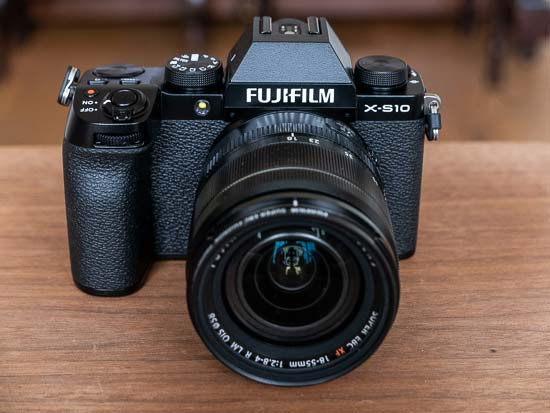
Weighing in at 465g and measuring 126 x 85.1 x 65.4mm, the X-S10 is 20% lighter and 10% smaller than the X-T4, which in turn is slightly lighter and smaller than the X-H1 model.
Physically it sits between the X-H and X-T series, looking like those two cameras have been merged together to create the new X-S series.
In terms of its marketing position, it sits above the X-T30 and below the X-T3 and X-T4 in the current X-series range.
Despite being so small and light, the X-S10 offers a very impressive level of build quality – much better than the X-T200, for example - something that we didn't expect from what is after all a sub-£$1000 camera.
Note that as per all other Fuji mid-range cameras, the new XS10 doesn't offer any level of weather-sealing. You'll need to step-up to the X-T4 to get that.
Large Hand-grip
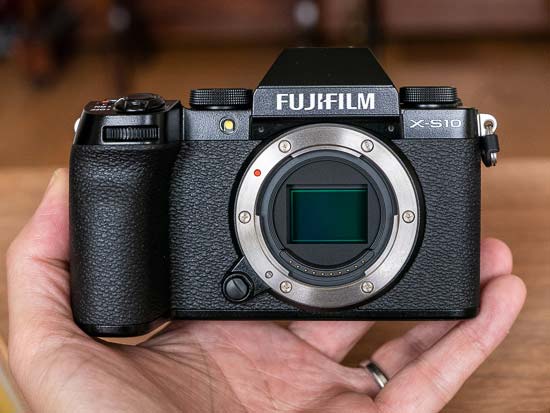
The Fuji X-S10 has an impressively large hand-grip for such a small camera, which is the direct result of the battery being moved into the grip to accommodate the new IBIS unit.
It's big enough to wrap three fingers of your hand around, with your right forefinger operating the shutter button.
The large grip helps to make the camera more stable when paired even with one of Fujifilm's larger telephoto lenses.
In-body Image Stabilisation (IBIS)
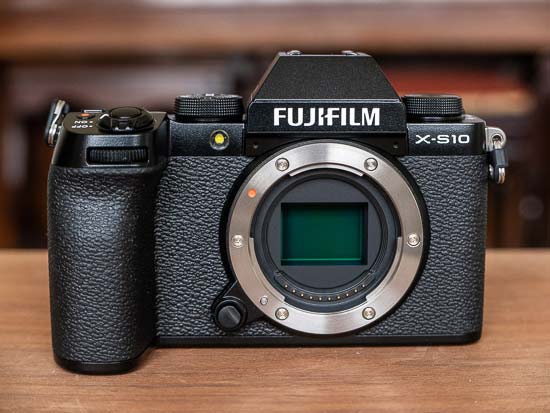
Despite being substantially smaller and lighter than the other two Fujifilm cameras that have IBIS, the X-H1 and X-T4, the new XS10 still manages to squeeze in a very good stabilisation system.
This is the first time that in-body image stabilisation (IBIS) has been incorporated in a mid-range Fujifilm body.
The first Fujifilm camera that had this feature was the now discontinued X-H1, which was launched back in 2017 to not-so-popular acclaim, mainly because it was much bigger in order to incorporate the IBIS unit.
Fujifilm's engineers were then hard at work in the intervening three years and managed to drastically shrink the IBIS unit in the X-T4, making it 30% smaller and 20% lighter than the one in the X-H1.
Now with the new Fuji X-S10, they've shrunk the IBIS unit further still, once again making it 30% smaller and lighter, but this time compared to the one in the X-T4.
The only slight drawback to this impressive size reduction is a modest reduction to the amount of stabilisation that's on offer.
The 5-axis system in the X-T4 provides up to 6.5 shutter steps of compensation, whereas the one in the X-S10 tops out at 6 stops.
This is still half a stop better than the 5.5 offered by the X-H1, though, which is no mean feat given the overall size of the new camera.
PASM Dial, No Manual Controls
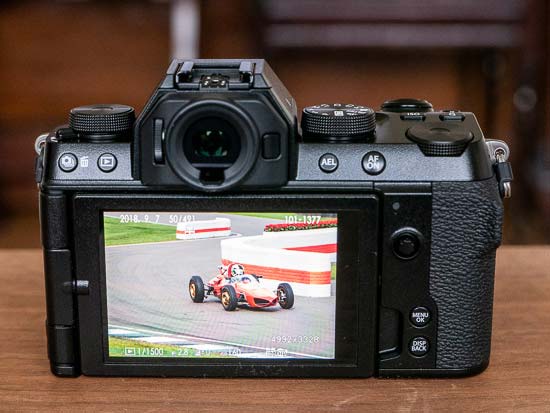
The XS10 has a shooting mode dial on the top-plate rather than the usual array of manual controls that Fujifilm include on their higher-end cameras.
So instead of the ISO dial, Shutter Speed dial and Exposure Compensation dial which adorn the top of the X-T4, there's a Function dial on the left of the X-S10 which by default changes the film simulation mode, and a traditional PASM dial on the right.
This simplified interface has been designed to be less intimidating to new users who don't already have a vested interest in the Fujifilm X-series system, or to those who don't appreciate manual controls as much as a simpler, more streamlined control layout.
Importantly the X-S10 still offers both front and rear command dials, though, which along with the customisable Function button still make it easy to quickly change the shutter speed, aperture and exposure compensation, depending on which shooting mode you're currently using.
Also found on top of the camera are the ISO and Quick Menu buttons, along with the one-touch movie record button.
On the rear of the XS10, the View Mode, AEL and AF ON buttons all double up as customisable Function buttons, while the 8-way AF joystick is a great addition to a mid-range camera.
The X-S10 impressively offers no less than four Custom shooting modes on the PASM dial, and even better than that, you can choose to store AF/MF and shooting settings in each mode as well as the image quality setting, making it easy to setup different custom modes for different shooting scenarios/techniques. Note that this only works for stills, not movies.
So despite the lack of traditional Fujifilm manual dials, the X-S10 still provides more than enough controls for the enthusiast user, as well as a simpler interface for beginners.
DCI 4K/30p and 1080/240p Video
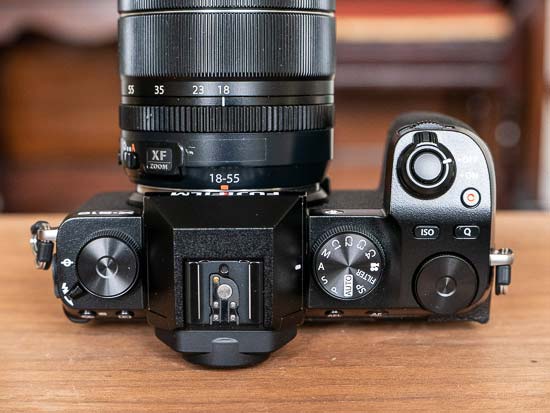
The X-S10 has a pretty good movie mode that more than holds its own against its main rivals.
It offers a highest quality rate of DCI 4K/30p with no crop recorded in 4:2:0 8-bit internally and 4:2:2 10-bit via the micro-HDMI port to an external recorder.
The F-Log profile is available, and movie compression is Long GOP only, with no All Intra option.
The maximum recording time is 30 minutes, which is actually 10 minutes longer than on the X-T4.
The Fuji XS10 also has the 1080p/240p 10x slow-motion mode, first seen on the X-T4, and the same digital image stabiliser which works in conjunction with the in-camera and lens-based systems.
Other key video features include IS Mode Boost, dedicated movie recording mode accessed by the shooting mode dial on top of the camera, different Main menu and Quick menu systems for stills and video modes, a 3.5mm MIC socket and a USB-C to headphone adapter provided in the box.
Finally the X-S10 has a brand new video feature never before seen on a Fujifilm camera - a count-up clock that displays the card capacity in hours and minutes when the camera is in Standby mode, which switches to showing the recording time in minutes and seconds in the Record screen.
So the main differences between the XS10 and the X-T4's video mode are the maximum frame rate in 4K - 30fps versus 60fps -, the movie compression - Long GOP versus Long GOP/All Intra -, the internal bit rate - 8-bit versus 10-bit -, and the recording time - 30 mins versus 20 mins.
Eterna Bleach Bypass Film Simulation
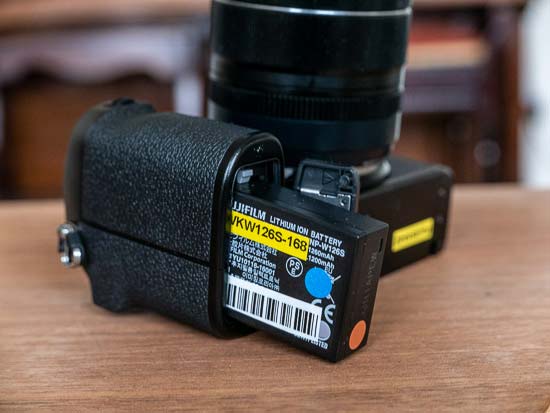
The new Eterna Bleach Bypass film simulation that first made its debut on the X-T4 has also now been included on the X-S10.
This is principally aimed at videographers who want a similar look to films like Seven, Saving Private Ryan and Fight Club, providing a hard tonality to the footage.
Better Film Simulation And Auto Modes
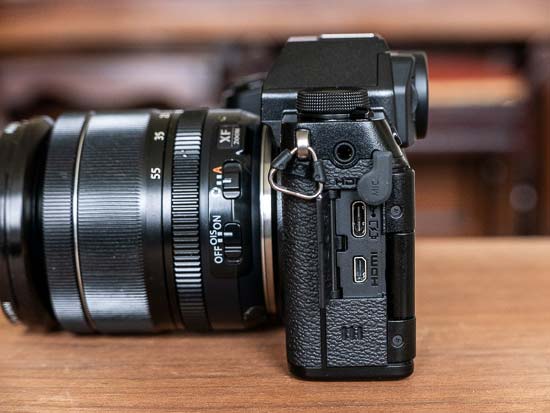
Fujifilm have also made some improvements on the XS10 to their almost legendary range of film simulation modes and to the beginner-friendly automatic shooting modes.
As well as being able to quickly select one of the 18 film simulations using the Function dial, you can view a short description of each one by pressing the Q button.
There's also a brand new algorithm for the Auto and Scene Position shooting modes, where the camera will attempt to automatically improve a landscape image, for example, by applying the clarity control and colour chrome blue to enhance the sky.
There's a new Auto film simulation mode, which chooses between Provia, Velvia and Astia, depending on the scene.
For the very first time, Raw files can be recorded in the Auto and SP shooting modes - previously only Fine or Normal JPEGS could be selected.
And last but not least, the AF mode can also now be selected when using the Auto and SP shooting modes, with a choice of single point, zone and wide (previously only wide was available).
LCD Screen and EVF
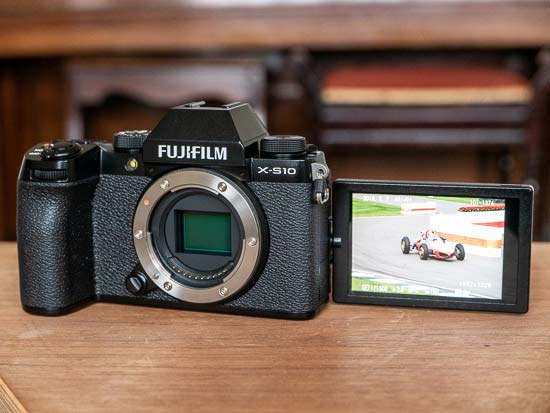
The X-S10 has a 3-inch 1.04M-dot vari-angle LCD screen that can be tilted out to the side and rotated forwards, and also folded against the back of the camera to help protect it when not in use.
The EVF is a 2.36M-dot unit with 0.62x magnification, 100fps refresh rate and a built-in eye sensor.
Burst Shooting
The X-S10 offers 8fps continuous shooting when using manual shutter, increasing to 20fps when switching to the electronic shutter without any crop, or 30fps with a 1.29x crop applied.
Pop-up Flash
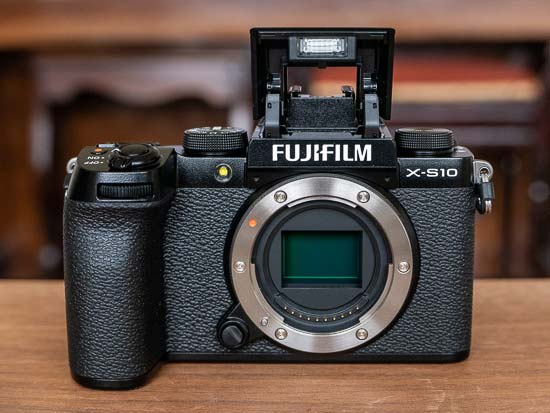
Fujifilm still believe that a built-in flash is an important feature on their lower-mid tier cameras, so the new X-S10 comes with a pop-up flash that's activated by a switch on the left of the top-panel.
Memory Cards
Perhaps unsurprisingly given its size, the Fujifilm X-S10 only has a single SD UHS-II memory card slot, rather than dual slots, which is more inconveniently housed in the battery compartment on the bottom of the camera, rather than on the side.
Image Quality
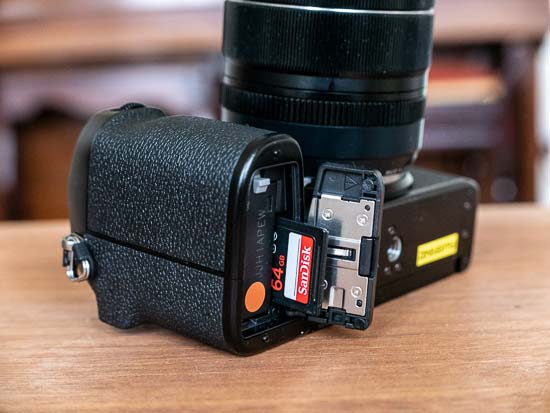
Impressively the Fujifilm X-S10 has exactly the same 26 megapixel APS-C sized BSI X-Trans image sensor as the X-T4 and the X-Pro3, so still image and movie quality should be pretty much the same.
We've already shot a gallery of sample JPEG and Raw images and movies for you with a pre-production version of the X-S10 which you can check out, and we'll be bringing you even more sample images when we get our hands on a final review sample.
Take a look at some sample JPEG and Raw images and movies taken with the Fujifilm X-S10 camera
Pricing and Availability
In the UK the Fujifilm X-S10 will go on sale in mid-November 2020 priced at £949 body only, £999 with the XC 15-45mm lens, £1299 with the XF 18-55mm lens, or £1399 with the XF 16-80mm lens.
In the US, the X-S10 body-only is $999, with the XF 18-55mm F2.8-4 R lens kit $1399, and with the XF 16-80mm F4 R OIS WR lens kit $1499.
Early Verdict
Fujifilm see the X-S10's main rivals as being the Nikon Z50, Sony A6600 and Canon EOS M6 Mk II, all cameras with APS-C sensors, but all lacking the breadth of lens support that Fujifilm currently offers (35 native lenses in total).
With the recent drive towards ever more full-frame cameras, retailers are apparently excited by the prospect of a cheaper, sub-£$1000 APS-C camera, as not everyone wants to spend more than that on a high-quality camera.
With 53% of the UK cameras market being comprised of sales of non-full-frame - 10% MFT and 43% APS-C - Fujifilm strongly believe that there's a big potential audience for the new XS10.
Having spent a little time with the new X-S10, we can certainly see their point. It's an intriguingly different proposition to the X-T and X-H series cameras in terms of its design, yet one that offers the same image quality and a lot of the core features at a lower price-point.
What do you think of Fujifilm's new mid-range mirrorless marvel? Leave a comment below!
Image Gallery
Click on a thumbnail to see the full version.
Hands On
Want to see exactly what the new Fujifilm X-S10 mirrorless camera looks like in the flesh?
Check out our hands-on gallery of photos of the Fujifilm XS10 mirrorless camera with the XF 18-55mm f2.8-4 R LM OIS lens attached.
A gallery of hands-on photos of the Fujifilm X-S10 mirrorless camera.
Image Gallery
Click on a thumbnail to see the full version.
Preview Images
Ahead of our full review, here are some sample JPEG and RAW photos and videos taken with the brand new Fujifilm X-S10 mirrorless camera.
A gallery of sample images taken with a pre-production version of the Fujifilm XS10 mirrorless camera.
All of the images were taken with X-S10 and the Fujifilm XF 18-55mm f2.8-4 R LM OIS kit lens.
Fujifilm X-S10 Sample Images
1/210s · f/8 · ISO 160
27mm
Download Original
1/320s · f/8 · ISO 160
83mm
Download Original
1/42s · f/5.6 · ISO 160
27mm
Download Original
1/210s · f/4 · ISO 160
56mm
Download Original
1/42s · f/8 · ISO 400
43mm
Download Original
1/125s · f/4 · ISO 160
69mm
Download Original
1/80s · f/4 · ISO 160
73mm
Download Original
1/90s · f/4 · ISO 160
83mm
Download Original
1/26s · f/11 · ISO 500
27mm
Download Original
1/52s · f/11 · ISO 640
54mm
Download Original
1/50s · f/8 · ISO 200
49mm
Download Original
1/80s · f/4 · ISO 400
83mm
Download Original
1/80s · f/4 · ISO 320
83mm
Download Original
1/27s · f/11 · ISO 160
27mm
Download Original
1/80s · f/11 · ISO 500
83mm
Download Original
1/80s · f/11 · ISO 400
83mm
Download Original
1/26s · f/11 · ISO 320
27mm
Download Original
1/250s · f/4 · ISO 160
83mm
Download Original
1/26s · f/8 · ISO 1250
27mm
Download Original
1/80s · f/4 · ISO 320
83mm
Download Original
1/26s · f/11 · ISO 2500
27mm
Download Original
1/80s · f/4 · ISO 1250
83mm
Download Original
1/34s · f/8 · ISO 640
35mm
Download Original
1/80s · f/8 · ISO 640
83mm
Download Original
Sample RAW Images
The Fujifilm X-S10 enables users to capture RAW and JPEG format files. We've provided some Fujifilm RAW (RAF) samples for you to download (thumbnail images shown below are not 100% representative).
1/210s · f/8 · ISO 160
27mm
Download original
1/320s · f/8 · ISO 160
83mm
Download original
1/42s · f/5.6 · ISO 160
27mm
Download original
1/210s · f/4 · ISO 160
56mm
Download original
1/42s · f/8 · ISO 400
43mm
Download original
1/125s · f/4 · ISO 160
69mm
Download original
1/80s · f/4 · ISO 160
73mm
Download original
1/90s · f/4 · ISO 160
83mm
Download original
1/26s · f/11 · ISO 500
27mm
Download original
1/52s · f/11 · ISO 640
54mm
Download original
1/50s · f/8 · ISO 200
49mm
Download original
1/80s · f/4 · ISO 400
83mm
Download original
1/80s · f/4 · ISO 320
83mm
Download original
1/27s · f/11 · ISO 160
27mm
Download original
1/80s · f/11 · ISO 500
83mm
Download original
1/80s · f/11 · ISO 400
83mm
Download original
1/26s · f/11 · ISO 320
27mm
Download original
1/250s · f/4 · ISO 160
83mm
Download original
1/26s · f/8 · ISO 1250
27mm
Download original
1/80s · f/4 · ISO 320
83mm
Download original
1/26s · f/11 · ISO 2500
27mm
Download original
1/80s · f/4 · ISO 1250
83mm
Download original
1/34s · f/8 · ISO 640
35mm
Download original
1/80s · f/8 · ISO 640
83mm
Download original
Sample Movie & Video
This is a sample movie at the quality setting of 4096x2610 pixels at 30 frames per second. Please note that this 30 second movie is 373Mb in size.

Loading comments…